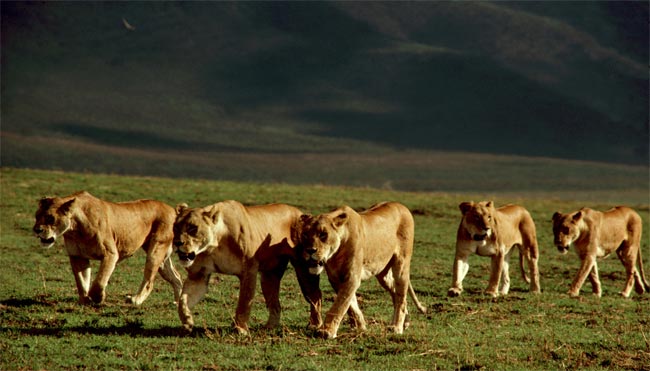Why Beasts Stick Together

Social cliques among wild animals in the Serengeti are actually the glue that holds the ecosystem together and keeps population numbers stable.
A new study could explain why birds flock, wildebeest herd, bees swarm and fish school: They are less likely to become a predator's next meal if they stick together. Rather than a food-sharing issue, the reason for lion prides, for example, could have more to do with territory defense and protection of their young.
The tendency to "follow the crowd" and travel in packs is nothing new and anyone who has tried to exit a concert or sporting event knows, it's natural to follow others.
In fact, past research revealed herds that are "democratic," with more followers than leaders, are more likely to stick together. Gangs of ants were found in another study to be more aggressive than singlets. But how social groups can shape an ecosystem has been somewhat of an unknown until this Serengeti study.
"The greater the tendency to form groups, the higher the stability of numbers of both species over time," said lead author John Fryxell, an integrative biologist at the University of Guelph in Canada.
The research is detailed in the Oct. 25 issue of the journal Nature.
Social beasts
Sign up for the Live Science daily newsletter now
Get the world’s most fascinating discoveries delivered straight to your inbox.
Ecological theory generally describes how animal populations interact based on their individual numbers. For instance, an ecologist could say that as the numbers of plant-eating wildebeest soar so will those of their lion predators, with booms and crashes normally following.
In reality, observers see fewer population booms and crashes. That's because the playing field changes when the animals form groups such as lion prides or herds of wildebeest. (The study scientists defined a social group as occurring when animals live within an area of two hectares, or about five acres, of one another.)
"Traditional ecological models have erroneously predicted that predators would inevitably over-exploit their prey, leading to frequent population crashes," said Fryxell's co-author, University of Minnesota ecologist Craig Packer.
"Most highly vulnerable prey species form herds, swarms, schools or flocks," Packer said. "And group-living reduces predators' efficiency to the point where co-existence is likely to be the rule rather than the exception."
Serengeti dynamics
Fryxell, Packer and their colleagues examined a slew of data on predatory lions and their prey—plant-eating wildebeest—living along Africa's Serengeti Plains, including: four decades of reported observations on lion behavior and population numbers, data on lion-hunting behavior and success, and censuses of wildebeest and other herbivore herds in the area.
With the data, they used computer models to figure out how group-living by just the prey or predator, as well as by both species, would affect their respective populations and the ecosystem as a whole.
The ecologists found that when wildebeest prey aggregated in clumps, the lions were less likely to snag them, resulting in a lower consumption rate for each lion than when the wildebeest lived as individuals.
When both the lions and wildebeest formed groups, prey intake plunged even more. Compared with no-group ecosystems (all animals strewn across the Serengeti), grouping caused a 90-percent reduction in kill rates for lions.
The reduction was similar to what the researchers found for another predator-evading strategy—seasonal migration. Several prey species, including wildebeest and zebra, spend most of the year in areas far out of reach of a given lion pride. If practiced in tandem, with herds of wildebeest migrating, they could reduce being eaten by two orders of magnitude.
For the greater good
Even though lions in prides seem to get the short end of the stick (less food) compared with solitary lions, overall, the social cliques worked as ecosystem stabilizers, with both lion and wildebeest populations remaining relatively level over time.
In contrast, when both species wandered the plains singly, the models showed the numbers of individuals in both populations would be erratic and unstable, cycling from highs to lows and likely leading to the extinction of both predator and prey.
The results help to explain why the extinction of predators and prey, as predicted by some models, is not observed regularly in the wild, notes Tim Coulson of the Imperial College London, in an accompanying Nature article. Coulson was not involved in the recent study.
To get a better understanding of wildlife dynamics, ecologists should consider the effects of group formation, the authors say.
"People hadn't appreciated the degree to which group formation has implications. This work shows that perhaps we should take a closer accounting of grouping patterns," Fryxell said.
- Video: Massive African Wildlife Migration
- Top 10 Deadliest Animals
- Image Gallery: The World's Biggest Beasts
Jeanna Bryner is managing editor of Scientific American. Previously she was editor in chief of Live Science and, prior to that, an editor at Scholastic's Science World magazine. Bryner has an English degree from Salisbury University, a master's degree in biogeochemistry and environmental sciences from the University of Maryland and a graduate science journalism degree from New York University. She has worked as a biologist in Florida, where she monitored wetlands and did field surveys for endangered species, including the gorgeous Florida Scrub Jay. She also received an ocean sciences journalism fellowship from the Woods Hole Oceanographic Institution. She is a firm believer that science is for everyone and that just about everything can be viewed through the lens of science.









